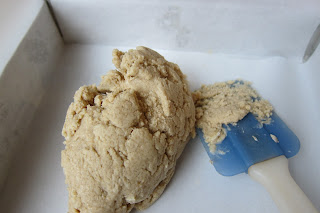 |
| Unassuming, but pecan-pie satisfying. |
I can hardly blame him. Some of my cookies have been worthy of the calories, and some have been a bust.
 |
| Doughy bottom layer requires serious spreading into all corners of the pan. |
The second surprise was the new taste and texture of the topping. It starts with the same eggs and sugar as in my lemon bars recipe. The lemon juice (in the lemon bars) makes a gelatinous topping when mixed with eggs and sugar. Some subtle and not-so-subtle ingredient swap-outs result in a completely different treat.
 |
| Parchment paper lining is essential to lift entire pan of bars from pan. |
Substitution Note: Although the recipe calls for walnuts, pecans are my typical substitute. Having grown up in walnut country (California), maybe I'm bored with them. But pecans have a better crunch and come with a toasty flavor even before they are toasted.
Gooey, caramelized and loaded with flavor. Friends gave them rave reviews.
The recipe is here and here.
My husband will enjoy these - he loves coconut, which isn't my favorite (safe for me which will allow me more calories to devote to shortbreads). Another one for my holiday baking. -Claudia
ReplyDelete